


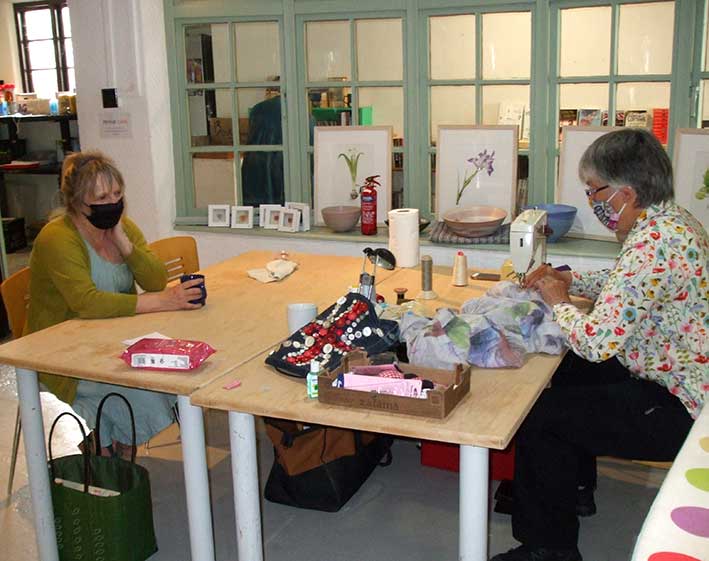

In 2024, 181 items were brought into our Repair Cafe. Our dedicated volunteer repairers were able to repair 137 of these saving a total of 242.533 kg of 'stuff' from the waste system.
REPAIR CAFÉ DATES 2025:
The Repair Cafe is held at the Balsam Centre usually on the 4th Saturday of each month 10am - 12.30pm. Dates for the coming year are:
Saturday 25th January 2025You can also head over to our News Page or our One Planet Wincanton Facebook Page to see the current poster of what repairs are being offered at the next event.
Back in March '24, we were joined by a Strode College Student who chose to capture the Wincanton Repair Cafe as part of their media studies course work. The outcome is this brilliant short film! Click here to watch it.
The Repair Café has been running successfully since June 2021 and to date 833 kg of ‘stuff’ has been saved from the waste system. We couldn’t have done this without the 26 volunteers, past and present, who generously give up their time on a Saturday every month. We are now able to offer electrical and electronic repairs, sewing, mechanical, jewellery, leather repairs and crochet. Check local posters or Facebook posts for each month's repairs.
The main purpose of the Repair Café is to save resources and reduce carbon emissions. We throw away a vast amount of stuff unnecessarily. Somerset Waste Partnership now sends non-recyclable rubbish to an energy-from-waste plant in Avonmouth. This is better than landfill, but it still takes energy, fuel and time to collect and transport the rubbish there. Anything new we buy also takes raw materials, water, energy and time to manufacture with (depending on where and how it is made) pollution as a probable side effect and then has to be transported to the retailer sometimes over great distances and on to us which also uses resources. And ALL these processes produce carbon.
A Repair Café can save many of these items from being wasted when they are damaged or worn, save resources and save you money! At the Repair Café one of our volunteers will repair the item you bring, if it’s possible, to make it useable or wearable again. You may like to sit with the repairer and see how it’s done, they may be able to show you how to carry out a repair yourself, or you can chat to someone else and you can have a drink while you wait.
The electrical and electronics repairers are all qualified, as is the leather repairer, and all repaired electrical items are PAT tested for safety.
If a repair is not possible there and then, the volunteers can often advise you if - and where - you can get it sorted out. We have a list of Wincanton High Street shops who may be able to help if we can’t. Repairers are not expected to take things home to repair (they give up enough time already) but occasionally they may offer to do so.
We are open once a month except in December, usually on the fourth Saturday, from 10.00 to 13.00 (last repairs accepted at 12.30) - in The Balsam Centre.
We will let you know what repairs we will be offering and confirm dates on the One Planet Wincanton Facebook Page, and on posters around the town.
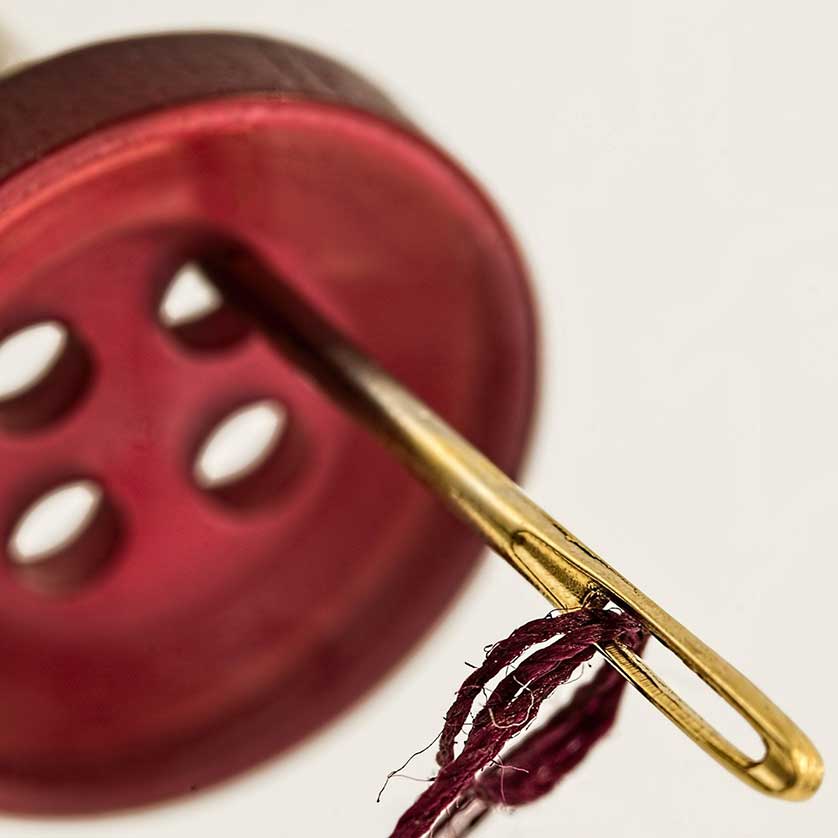
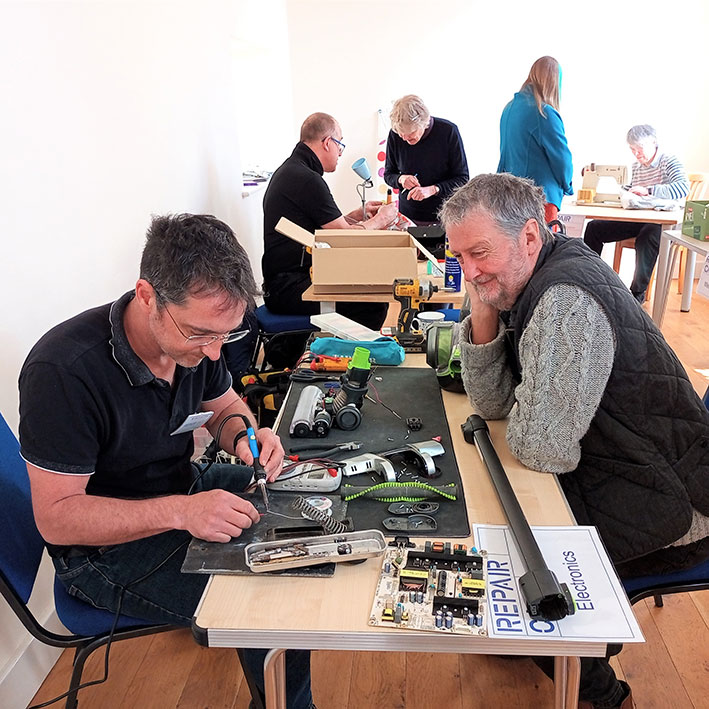
This is a FREE service (except for any parts used which we ask you to pay for) – all freely given by our amazing volunteers - it costs £100 a month to run the Repair Cafe in room hire, insurance and other costs. Any donations you are able to make will be gratefully received and will go towards our running costs.
Do you have any repair skills? If so, you might like to join our team of repairers if it's a skill that is in demand. Even if we already have a repairer with the same skills, it’s useful to have someone to step in if they’re away for some reason so that we don’t have to disappoint people who bring repairs. If you would like to help, please email: oneplanetwincantonREMOVEREMOVEREMOVE@REMOVEgmailREMOVE.REMOVEcom
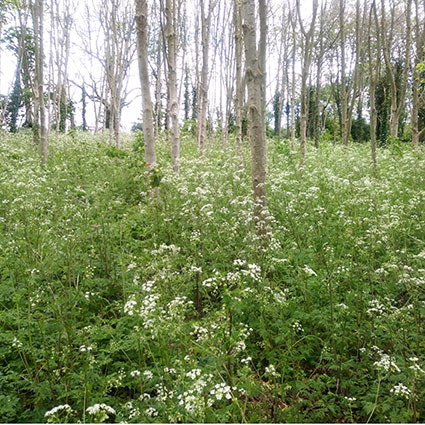
In 1985 Cash’s Park (also known as Coneygore Green) was donated by the Cave family to be kept as an open space for the enjoyment of the people of Wincanton. The Copse, also part of this gift, is the tree covered hill above it.
This copse is a haven for wildlife. It has mature beech, lime and hornbeam trees, one of which came down in a storm in 2019. There is a variety of younger trees including wild cherry, horse chestnut, sycamore, oak and many ash which were crowding each other out in the middle of the copse. With permission from the Town Council, we enlisted help from Simon Wiltshire, a biodiversity professional, who felled 15 of the ash. These were smaller ones in poorer health to allow more room for retained trees to spread out and to let more light through to the ground to encourage ground flora. Two larger ash were felled that were shading out a small plantation of oaks, which now have more light and space. Given the amount of ash trees still there, which may not have a long term future (due to the threat of ash dieback disease), we have planted new native saplings cherry, hazel and hawthorn to replace them, also wild flowers, particularly bluebells. The middle of the copse is currently a sea of cow parsley, common hogweed and some red campion.
In one corner of the copse you can see some sheets of scrap metal. These are not just rubbish but offer shelter for invertebrates and reptiles. Rotting logs are also a good habitat for invertebrates and piles of cuttings for invertebrates or small mammals. There is evidence that fox and badger use the copse and we are looking in to the possibility of installing one or more owl boxes there and possibly other bird boxes.
Some of the ash tree cuttings have been used to mark out a circular path and access steps have been installed from the park so that more people can enjoy the peace and quiet and the wildlife that lives here.
Also, in answer to questions from a couple of members of the public, this is not a throughway. The public footpath to the fields and over the hill is still via the gate and steps to the left of the bench at the top of Cash's Park.
We welcome new volunteers. Experience is not necessary. If you would like to help when we are next planting in the Park or Copse or carrying out maintenance work, please email: oneplanetwincantonREMOVEREMOVEREMOVE@REMOVEgmailREMOVE.REMOVEcom
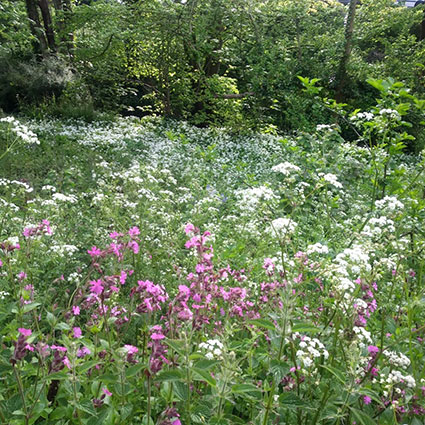
With many thanks to James Cooper who has experience of surveying with the RSPB, we (well, James actually) identified the following this morning:
Cash's Copse:
1 Wren M, 1 Robin M, 1 Chiffchaff M, 1 Great tit M, 1 Dunnock F, Blue tit pair inspecting one of our new nest boxes, Woodpecker nest holes
Cash's Park:
2 Robin M, 1 Wren M, 1 Nuthatch M, 1 Collared dove M, 1 Dunnock M, 1 Blue tit F, 1 Woodpigeon F, Blackbird pair, Great tit pair. Sparrowhawk and Red kite flying over.
The males were singing to hold their territory.
We hope to repeat this when the summer migrants are here.
Many of the plants in the Copse have been dormant over the winter and the sea of white Cow Parsley in the middle had died down although their new bright green leaves are now coming through again. Over the last year we have planted primroses and other woodland plants as a trial and we hope, soon, some of them will flower.
In June we had a visit from Chris Sperring, South West Conservation Officer for the Hawk & Owl Trust who has supplied a Tawny Owl box for the Copse which we hope to have installed soon. It is one of the Trust’s registered boxes and they will monitor it once a year.
We’ve also had a number of bird boxes made by Wincanton Men’s Shed and hope to have these installed in the Copse at the same time as the owl box ready for the 2022 nesting season. The birds are pretty active with the current spell of warm weather but with cold weather pretty sure to come they won’t start nesting in earnest yet.
In Cash’s Park we planted a small group of crab apple trees, primroses around the beech tree and several test beds of wild flowers, as plug plants, between the path and the old hedgerow. These did well and, in preparation for this year, we have had a much longer strip of turf lifted and have sown a mix of wild flower seeds. The reason for lifting the turf is because rich grass is too fertile for many wild flowers and bare soil is a better medium for their seed to be sown in. Look out for when they start sprouting.
We had an owl box and some bird boxes installed early in the year. Sadly, some of the birdboxes have been vandalised. Undeterred, we are reinstalling the ones we’ve been able to recover but higher up, and some in different positions, in the hopes this will keep them safe. If you notice any damage to any of them we’d appreciate you letting us know via our email oneplanetwincantonREMOVEREMOVEREMOVE@REMOVEgmailREMOVE.REMOVEcom
Some of the bluebells we planted earlier in the year have flowered and we have just planted some more along with a woodland mix of wild flower seeds.
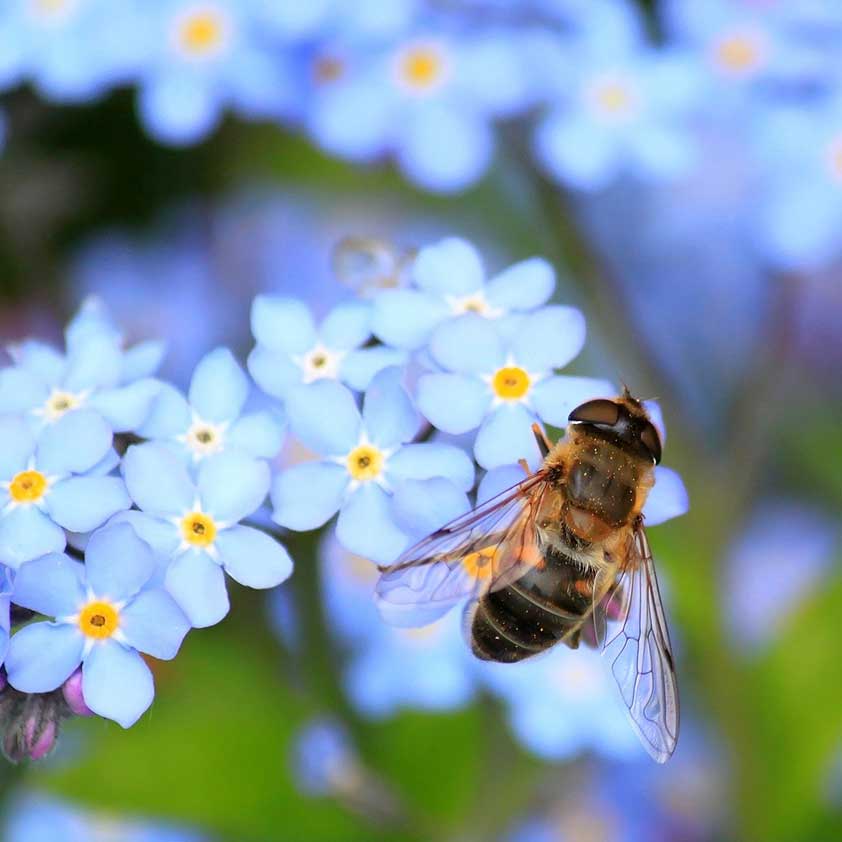
Many plants depend on animals, particularly insects, to transfer pollen as they forage. Plants attract pollinators in various ways, by offering pollen or nectar meals and by guiding them to the flower using scent and visual cues. This has resulted in strong relationships between plants and the animals that pollinate them.
It is estimated that 65% of all flowering plants require insects for pollination. This percentage is even greater for economically important crops that provide fruits, vegetables, textile-related fibres and medicinal products. Because insects are such efficient pollinators, plants have developed many ways of encouraging them to visit. This has led to some strong associations between plants and insects.
Pollination is the delivery of pollen to the female organs of a plant (stigma in flowers). Pollen is made by the male organs of a plant (stamens in flowers) and contains genetic information needed for plant reproduction. Pollen may be transferred to female organs on the same plant (self-pollination) or another plant of the same species (cross-pollination). As a result of pollination the plants produce seeds. Pollen can be dispersed by wind, water and animal pollinators such as insects, bats and birds.
Species of bees, beetles, flies, wasps, thrips, butterflies and moths are all successful pollinators.
Due to various causes, we have lost 50% of our insects since 1970. If we grow plants that will attract and support them we can help reverse that decline.
We can all:
We have kindly been loaned the use of a large bed in what was the kitchen garden behind Clementina. Having had veg grown there for a number of years, the soil is good. We’ve planted a range of flowering plants, largely grown by the Growing Space, and aim to have plants that will flower throughout the year to provide a food source for bees and other insects for as long as possible. We’ve also included some evening and night flowering plants for night-flying moths.
The plants include angelica, aquilegia, aster, calendula, centaurea (cornflower), erysimum ‘Bowles Mauve’, evening primrose, forget-me-not, limanthes (poached egg plant), nigella (love-in-a-mist) night phlox, salvia, scabious and we’ve scattered some phacelia and some night-scented stock seeds. The garden also has an existing population of primroses, Spanish bluebells and nettles! If we want butterflies and moths, we also need to think about their caterpillars and nettles are a good food source for the caterpillars of red admiral, peacock, comma and small tortoiseshell butterflies.
It’s a privately owned garden but, conditions permitting, will be open for various events throughout the year. You’re also welcome to contact us if you would like us show you what we’re doing there.
Even though it’s not in a public space, the flowering plants we’re growing will directly benefit the insect population which in turn will help pollinate the vegetables being grown by Wincanton Fruit & Veg in the next bed and we will learn from it. We’ll hopefully improve on our successional flowering so that we have flowers available for as much of the year as possible. Ideally, we would like to replicate this in some public spaces next year.
We welcome new volunteers. Experience is not necessary. If you would like to help with weeding, watering or when we are next planting, please email: oneplanetwincantonREMOVEREMOVEREMOVE@REMOVEgmailREMOVE.REMOVEcom
We had a very good summer last year with the flowering annuals that were supplied by the Growing Space. We didn’t keep as good a track of what was planted as we might as we ended up planting the bulk of them in the pouring rain! However, the clary sage (Salvia viridis ‘Bue Monday’) and marigolds (Calendula officinalis ‘Indian Prince’) seemed to attract the most pollinators along with the white cosmos and asters (Michaelmas daisies) and some of the ‘weeds’ or native wild flowers. We also had evening primrose and Phlox ‘Midnight Candy’, which only opens as night, to attract moths.
Other biennials and perennials were donated from various sources and we added some late and very early flowering plants to provide nectar for as much of the year as possible. These include a Mahonia ‘Winter Sun’ and crocus. Some bumblebees can be seen as late as December and the first ones, usually buff or white-tailed bumblebees, start to emerge from their winter hibernation in February and will need to start feeding immediately.
All this has been possible thanks to Claudia Cole and Zac Greening who have been managing the space and Nicholas Cave the owner. It’s a wonderful old walled garden which has been open to the public for specific events but to the bees and other insects all year round!
We’re now looking to do something similar in a public space and are in discussion about the most appropriate site.
We no longer have the use of the garden at Clementina although we’ve been very grateful for the time we’ve had there and numerous pollinating insects will have benefitted from the flowering plants we grew there. We were able to salvage a number of the plants many of which then appeared at our recent Plant Swap. Some have also been donated to the Growing Space who give us a lot of support by providing storage for our tools, lending tools and propagating plants for us. However, as one door closes another opens …………. (see Wilder Churches / see below)
Wilder Churches is a new partnership initiative between Somerset Wildlife Trust and the Diocese of Bath and Wells that is supporting communities in finding ways to increase the value of their churchyards for wildlife. As part of this, with the support of the Parochial Church Council and, of course, our Rector Alison Way, some of the margins of our parish churchyard have been allowed to grow longer this year to see what will grow naturally. You may have seen notices about this on the churchyard gates.
In 2022 Germander speedwell, Ribwort plantain, Mouse-ear hawkweed, Herb robert, Herb bennet, Common sorrel, Cow parsley, Red clover, Ox-eye daisy, plus some even more common flowers that everyone will know, flowered in these margins. In line with recommended wild flower meadow management practice, these areas have been mown after the existing flowering plants had set seed and we are raking these areas off to reduce fertility (which are the conditions wild flowers thrive in).
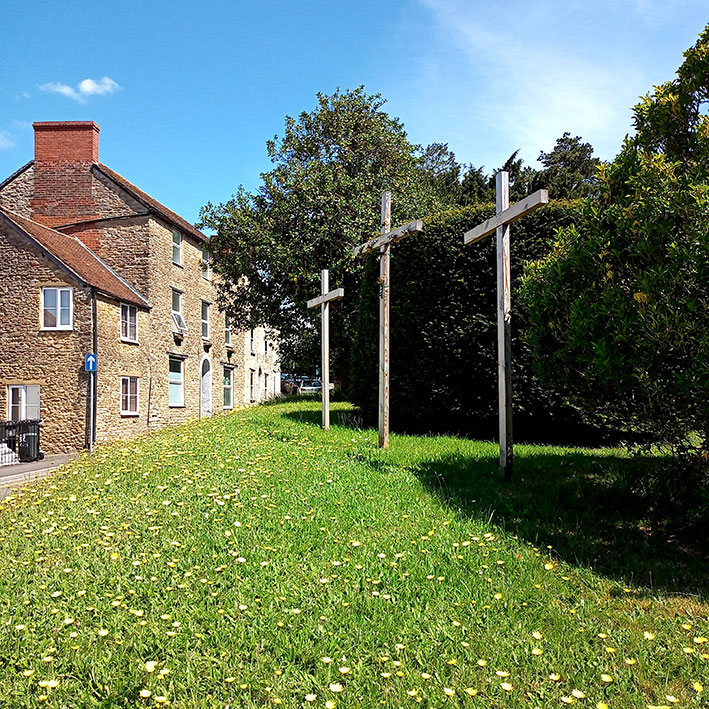
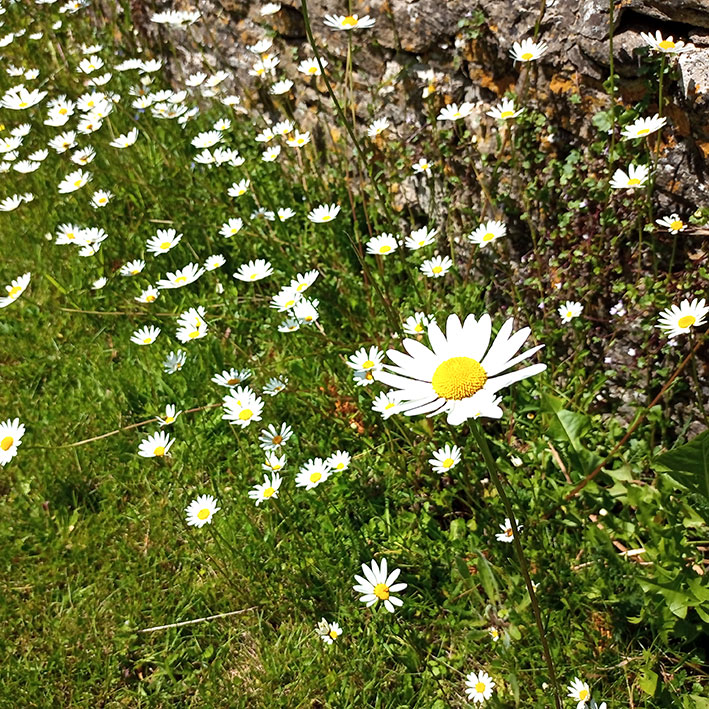
We will shortly be sowing more wild flower seed to increase variety and also hope to put up some bird boxes over the winter ready for next spring.
Steve, Shaun and John from the Town Council will continue to maintain the main parts of the churchyard as always.
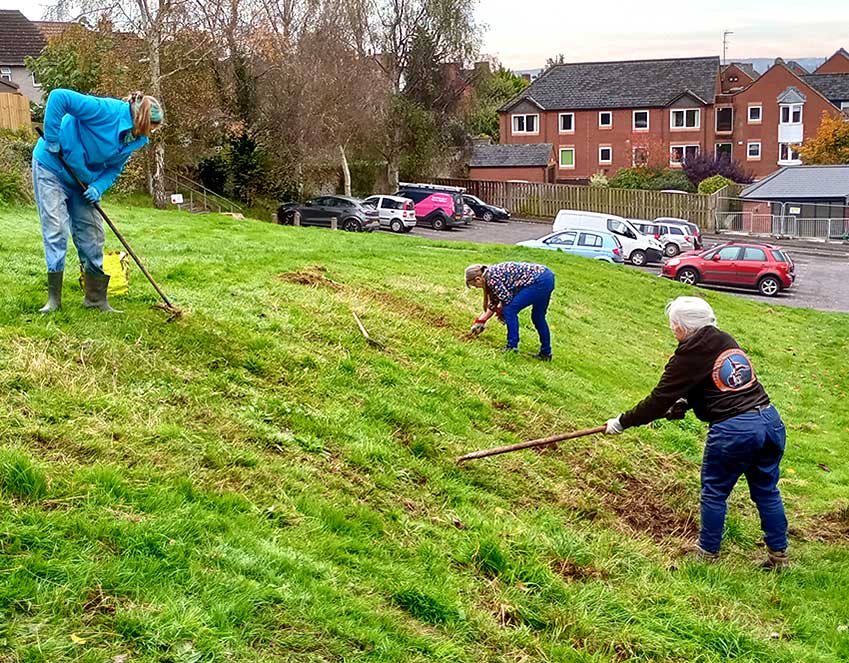
Some people will remember when the grassy area above the top Co-op car park had picnic tables and became known as the ‘picnic park’ a name which has stuck although it’s no longer used as such. It’s a green space not far from the High Street but also linked to the open fields to the north and Wrixon’s View to the west.
Last year, Wincanton Town Council Works & Maintenance Team left the grass on the bank in the centre of this area unmown to see which native wild flowers grow there and then gave it just one cut at the end of the summer. We then sought advice from Nick Mann of Habitat Aid who, after a site visit, advised that the growth on the further part of the bank showed that the soil there is lower in fertility so would be best suited to sowing more wild flower seed as more fertile ground encourages grass growth rather than native wild flowers. So, with permission from Wincanton Town Council, we have raked the cut grass off the further part of the bank, exposing as much bare soil as possible, and sown yellow rattle seed.
Yellow rattle is a semi parasitic plant and, as well as having attractive yellow flowers, will further weaken the grass to make it easier for wild flower seed to germinate and thrive. We’ll be sowing wild flower seed there next year. We also plan to plant bulbs for native or naturalised flowers on the more fertile area of the bank and also the lower bank adjacent to the car park. The rest of the area will be maintained as usual by Steve & Shaun of the Works & Maintenance Team.
If you’re interested in helping us when we’re working there please email us at oneplanetwincantonREMOVEREMOVEREMOVE@REMOVEgmailREMOVE.REMOVEcom